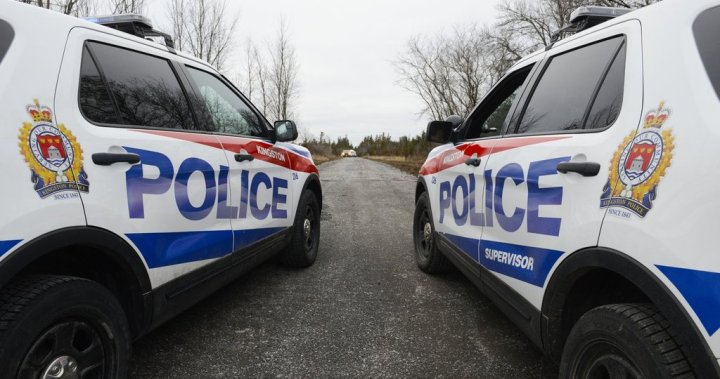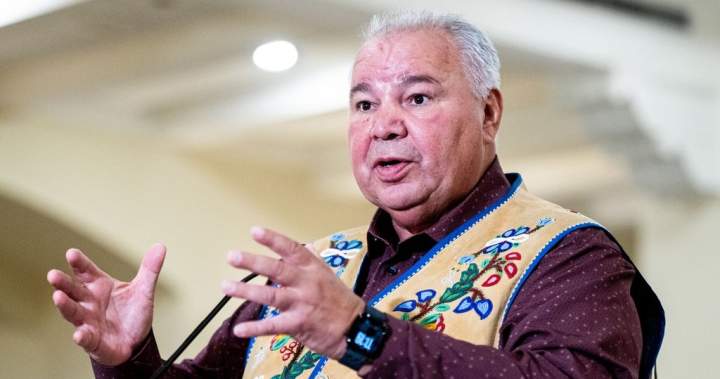Uncategorized
‘Uphill battle’: Criminal Code must include definition for femicide, advocates say

As police in Ontario increasingly investigate killings of women and girls as femicides, advocates say a firm definition of the term must be embedded in the Criminal Code.
It’s a change they hope could be on the table soon after Prime Minister Mark Carney proposed cracking down on intimate partner violence in this year’s federal election campaign.
Ottawa police, who have been using the term since August 2024, said last week they were investigating the death of a 54-year-old woman as a femicide. They arrested a 57-year-old man and charged him with second-degree murder.
Last month, Kingston Police logged its first use of the label in a news release.
Police said they determined the death of a 25-year-old woman to be a femicide because it occurred “in the context of intimate partner violence,” and they arrested a 26-year-old man for first-degree murder. They confirmed it was their first time describing a homicide in this way.
Police use the word so rarely that the Kingston example was a “very significant” move, said Myrna Dawson, founder and director of the Canadian Femicide Observatory for Justice and Accountability.
“That’s not something that’s really in their vocabulary right now. It’s not something that is in many people’s vocabulary as much as it should be,” she said.
Dawson, who is also a sociology professor at the University of Guelph, said the lack of Criminal Code definition is part of the reason why.
The observatory defines femicide as the killing of women and girls because of their gender.
The group also uses a framework from the United Nations Office of Drugs and Crime that lists 10 specific indicators that a crime could be considered femicide.
They include a woman or girl being killed by her intimate partner or family member, a victim having had a history of being harassed and sexual violence playing a role in the crime. In some cases, more than one factor can be at play.

Get breaking National news
For news impacting Canada and around the world, sign up for breaking news alerts delivered directly to you when they happen.
“They’re killed in distinct ways from men and boys, and they’re killed in many ways because of men and boys being entitled to relationships with them and expecting that women don’t get to decide when they don’t want a relationship any longer,” Dawson said.
Using the UN framework, her group has counted 1,014 femicides across Canada since it began tracking the killing of women and girls in 2018.
That included 187 femicides last year. A current or former intimate partner was accused in nearly half of those cases, the observatory found. Family members were accused in another 28 per cent of cases. Only six per cent of alleged perpetrators were strangers to the victims.
Though Kingston police have now called one case a femicide, the group’s data suggests at least four killings since 2018 could meet the definition.
Other groups are attempting the same work. The Ontario Association of Interval Houses, which tracks cases in the province, has identified five femicides in Kingston since late 2019.
Its executive director, Marlene Ham, said that without a universally recognized definition for femicide, different groups will end up with different numbers.
Adding a definition of femicide to the Criminal Code would allow better data on violence against women to be captured by police and national agencies such as Statistics Canada, both advocates said.
Kingston Police spokesperson Const. Anthony Colangeli declined to answer questions about what motivated the force to use the term femicide and whether it plans to use similar terminology in the future.
An Ottawa police spokesperson said the force started using the word femicide to “highlight the realities of gender-based violence faced by women in our community.”
“By using appropriate language to refer to these murders, we are continuing conversations about this subject that is often considered ‘private.’ We are raising awareness about an epidemic that is occurring and labelling these deaths appropriately,” the spokesperson said in an email.
In the absence of an agreed-upon definition, Ottawa police have come up with a list of 14 forms of violence that fall into the category of femicide, including intimate partner violence killings, the torture and misogynistic slaying of women, the killing of Indigenous women and girls, killing related to sexual violence and the “non-intimate killings of women and girls.”
The force confirmed it does not use femicide to describe women killed in murder-suicides — something Dawson said should change as it is “a very common scenario in femicide cases.”
Other police forces, such as the Toronto Police Service, don’t use the term femicide because it currently has no bearing on which charges police lay in homicides. The force does, however, lay terrorism charges in homicides where misogyny is a motivating factor.
Dawson says police are “fighting an uphill battle” when it comes to using femicide terminology more consistently.
“Police really need leaders to take the initiative, and by that I mean the federal government who decides what is a criminal offence and what should be labelled and legislated officially,” she said.
Carney promised in the campaign to make killings motivated by hate — including femicide — a “constructive first-degree offence,” which means a first-degree murder charge would be laid even if the slaying was not planned and deliberate.
Chantalle Aubertin, a spokesperson for Justice Minister Sean Fraser, said in a statement the government is “determined to bring forward legislation to advance this commitment as soon as possible.”
Should the federal government enshrine a definition of femicide, Statistics Canada could record better data, Dawson said.
The agency already tracks homicides reported by police each year, and the genders of the accused perpetrators and victims. While a 2023 report on gender-related homicides of women and girls broke down some indicators of femicide, it only addressed some of the UN’s indicators.
“The more we know about these killings and the more we can contextualize them within that understanding of femicide, the more awareness that we can ultimately build and continue to have these discussions about prevention,” Ham said, noting a history of threats, violence and coercive control is present in many cases.
It’s important to keep the conversation about violence toward women going, Dawson added, with an emphasis on how these killings differ from those targeting boys and men.
“That’s what we’re trying to emphasize because if we don’t recognize that, then our prevention efforts also don’t recognize that, and we don’t recognize the urgency of this.”
Uncategorized
Indigenous groups question government funding for Métis Nation of Ontario

First Nations in Ontario and the Manitoba Métis Federation say nearly $1 billion in federal funding went to a group they allege is fraudulently claiming Métis identity.
The Chiefs of Ontario, which represents 133 First Nations in the province, shared with The Canadian Press data on more than 20 years worth of federal funding provided to the Métis Nation of Ontario.
It suggests that $819,836,061 went from Ottawa to the MNO — an organization First Nations leaders say has no legitimacy and threatens their rights.
“This data shows just how badly First Nations in Ontario are being harmed by the diversion of government funding to the MNO and away from the needs of First Nations and other legitimate groups,” the Chiefs of Ontario said in a media statement.
“The question is, why is the Crown sending hundreds of millions of dollars to the MNO when there is overwhelming evidence contradicting their claims?”
The data indicates the money came from several federal departments, including Indigenous Services Canada, Crown-Indigenous Relations, Parks Canada and Environment and Climate Change Canada.
The MNO also received funds from the Canadian Nuclear Safety Commission and the Impact Assessment Agency related to the potential impacts of projects in their communities.
The conflict between First Nations, some Métis groups and the MNO stems from a 2017 decision by the government of Ontario to recognize six “new, historic” Métis communities in the province — and a 2023 federal government bill, which never passed, that would have affirmed the MNO’s right to self-government.
First Nations and other Métis groups say the communities represented by the MNO have no claim to Métis heritage and Ottawa and Ontario have no right to recognize them.

Last month, history professor Leila Inksetter of the University of Quebec in Montreal released a report drafted on behalf of the Wabun Tribal Council that concluded there is no evidence of a mixed-ancestry community in the Wabun Tribal Council’s territory in northeastern Ontario.
The MNO rejected that report, saying that despite years of outside attempts “to discredit” it, “nothing has changed.”

Get breaking National news
For news impacting Canada and around the world, sign up for breaking news alerts delivered directly to you when they happen.
“The facts of history will not change because a new ‘expert’ has been paid to peddle the same Métis denialism,” the group said in a media statement.
The MNO has cited a 2003 decision by the Supreme Court of Canada to recognize a Métis community in and around Sault Ste. Marie, Ont. The case did not consider the six new communities recognized in 2017, but rather what may constitute a Métis right.
Another report, published last month and commissioned by Saugeen Ojibway Nation, also concluded there is no evidence of a distinct Métis community in their territory in southwestern Ontario.
“The historical evidence simply does not support this claim,” says the nearly 200-page report, written by two historians at the University of Toronto.
While the report says there were “certainly individuals and families of mixed ancestry” in the region, that can’t form the basis of a claim to a distinct community within Saugeen Ojibway Nation territory.

Jennifer St. Germain, MNO chief strategy officer, said Métis and First Nations “should not be working at odds as we are not enemies.”
“We have worked together throughout our shared history to push colonial governments to respect the rights of Métis and First Nations peoples, to properly invest in the programs that matter to our families and communities, and to uphold the honour of the Crown,” she said.
“When the MNO and Ontario First Nations work together, we make real change for the better for our children, families, and communities, as well as our lands and waters.
“It’s time to get back to the table rooted in our shared values of honesty, truth, and respect.”
The Chiefs of Ontario says that the academic research “merely reaffirms reality.”
“Not only are Ontario and Canada refusing to consult First Nations, they refuse to share the research they relied on or acknowledge the growing body of research and take steps to fix their mistakes,” the Chiefs of Ontario said in a media statement.
“It is extremely disappointing that Canada and Ontario … failed to do any adequate research before recognizing the MNO.”
Open disputes over claims to Métis heritage came close last year to ripping apart the Métis National Council, which once acted as a national voice for Métis but now has just two provincial members.
The Métis Nation-Saskatchewan withdrew from the Métis National Council last September, citing concerns about the MNO and claiming the council had failed to ensure the integrity of its citizenship registry.

The Métis Nation British Columbia withdrew from the council shortly after, saying it had lost confidence in the council’s ability to serve as a national advocacy organization.
Their departure came years after the Manitoba Métis Federation withdrew from the council, citing similar concerns.
Will Goodon, the Manitoba Métis Federation’s minister of identity protection and inter-Indigenous affairs, said the amount of public money available to Métis communities is limited and should not be shared with bodies that are not connected to what he calls the historic Métis Nation — largely recognized as descendants of the Red River communities in Manitoba.
One Parks Canada grant received by the MNO was meant to allow the organization to secure land and “support creation of an ecological corridor in the region along the north shore of Lake Superior,” says a federal document.
Goodon said that type of funding raises red flags for both Red River Métis and First Nations concerned about the prospect of the MNO seeking land in their territories.

The Manitoba Métis Federation said it’s also troubled by the fact that the federal government last week invited MNO leaders to a meeting to discuss its controversial major projects legislation.
The federation, which boycotted that meeting, said the MNO’s invitation undermined the integrity of the gathering and put the government’s major projects agenda at risk.
“Canada and Ontario are pushing pro-development agendas. They say they will consult with ‘Indigenous communities’ but, in Ontario, the only consultations that should occur are with the rights holders — First Nations,” the Chiefs of Ontario said in a media statement.
“Pan-Indigenous approaches do not work and only devalue the true rights holders.”
© 2025 The Canadian Press
Uncategorized
Landlord says B.C. billionaire’s plan for Bay properties ‘defies commercial common sense’

Cadillac Fairview says a plan from a B.C. billionaire hoping to take over 25 former Hudson’s Bay leases “defies commercial common sense” and thus, she should not be allowed to move in.
In filings made with the Ontario Superior Court on Saturday, Cadillac Fairview says it is “resolutely opposed” to Ruby Liu becoming a tenant at some of its malls because she has no detailed or credible business plan.
The mall owner also says Liu, who owns three B.C. shopping centres herself, has no brand, experienced staff or track record in retail.
Her business is “an empty shell without any guarantee of financial means beyond Ms. Liu’s bare assertion that she will keep it afloat,” said Rory MacLeod, Cadillac Fairview’s executive vice-president of operations, in an affidavit. “All of the indications are that (her company) will run out of money before the first store opens.”
MacLeod’s affidavit ups the ante in a battle that has been festering between Liu and landlords since the Bay announced in May that it had chosen her to buy 28 of its leases. The first three got court approval and were transferred in short order because they were at Liu’s three malls.

The remaining 25, however, have been much more fraught. Those leases cover some of the country’s most prized retail space and came with cheaper rent and very attractive terms for the Bay, which filed for creditor protection under the weight of tremendous debt in March.
For example, the Bay paid $1.3 million in annual rent for 152,420 square feet at Fairview Mall in Toronto, court documents show, which is a fraction of what non-anchor tenants would pay.

Get breaking National news
For news impacting Canada and around the world, sign up for breaking news alerts delivered directly to you when they happen.
Unable to get most landlords onside with a lease transfer, the Bay asked a court at the end of July to force property owners to accept Liu as a tenant.
Liu and the Bay have until next Tuesday to respond to Cadillac Fairview’s allegations. A judge will hear the matter at the end of the month.
Liu has said she wants to turn the Bay stores she is hoping to buy into her own department store named after herself. She has repeatedly told The Canadian Press her stores will not just offer retail space but also dining, entertainment, kids play and recreation areas.
MacLeod says she’s also talked of outfitting Bay spaces with grocery stores, educational centres, senior’s facilities, robotics and musical performances.
Cadillac Fairview says leases at the six malls she wants from the company — Fairview Mall, Sherway Gardens, Masonville Place and Markville in Ontario, Market Mall and Chinook Centre in Alberta and Richmond Centre in B.C. — don’t allow for anything other than a department store to be operated there.

“Despite her private assurances that she intends to respect the lease terms, Ms. Liu has consistently presented a different idea to the public, one that would not be compatible with the leases,” MacLeod said.
His affidavit also raised concerns with the timelines and budget in her business plan.
Liu has said she will be ready to open at least 20 stores within 180 days of obtaining leases and will spend $120 million on “overdue” repairs to roofs, HVAC systems, washrooms, elevators and escalators and $135 million on initial inventory.
Cadillac Fairview says her proposed timeline is “entirely unrealistic” for a new brand, let alone an established one, and her plan is underfunded based on the high number of repairs properties need and expensive terms suppliers will require her to agree to.
MacLeod estimates the stores will need more than $15.8 million in repairs before the end of 2026 to bring the leases into good standing. By 2027, Liu will need to spend another $5.7 million on repairs, not including taxes, permits or fees for expedited labour.
Over the next 10 years, he estimates Liu will be required to spend at least $43.1 million on the Cadillac Fairview leases alone.
He also took issue with her staffing estimations, which show she will need 1,800 employees to carry out her plan.
If all 1,800 are sales staff that would only leave 64 people on the floor of each of her 28 stores. Macleod said such staffing levels are “inadequate to support a countrywide chain” and “inconsistent with a retail location even a fraction of that size.”
“With my decades of experience in commercial real estate, it is apparent to me and Cadillac Fairview that (Liu) will fail and again leave these stores vacant,” he said.
© 2025 The Canadian Press
Uncategorized
Heat warning issued for large part of Ontario, Quebec

A heat warning has been issued for a large part of Ontario and Quebec, with the hot weather expected to last multiple days, Environment Canada reports.
Daytime highs of 30 to 35 C are expected with the humidex values of 35 to 40 C.
Overnight lows will be cooler but will still hover between 19 to 22 C.

Get breaking National news
For news impacting Canada and around the world, sign up for breaking news alerts delivered directly to you when they happen.
Temperatures are expected to cool mid-week, which will start to bring an end to the heat, Environment Canada said.
The organization warns that extreme heat can affect everyone’s health and people should check on older adults, especially those living alone and other at-risk people.
Signs of heat exhaustion might include headache, nausea, dizziness, thirst, dark urine and intense fatigue.
Call 911 or your emergency health provider if you, or someone around you, is showing signs of heat stroke, which can include red and hot skin, dizziness, nausea, confusion and change in consciousness.
Environment Canada says heat warnings are issued when very high temperature or humidity conditions are expected to pose an elevated risk of heat illnesses, such as heat stroke or heat exhaustion.
© 2025 Global News, a division of Corus Entertainment Inc.
-

 Uncategorized2 months ago
Uncategorized2 months agoAccording to Dior Couture, this taboo fashion accessory is back
-

 Uncategorized2 months ago
Uncategorized2 months agoThese ’90s fashion trends are making a comeback in 2017
-

 Uncategorized2 months ago
Uncategorized2 months agoThe old and New Edition cast comes together to perform
-

 Uncategorized2 months ago
Uncategorized2 months agoUber and Lyft are finally available in all of New York State
-

 Uncategorized2 months ago
Uncategorized2 months agoNew Season 8 Walking Dead trailer flashes forward in time
-

 Uncategorized2 months ago
Uncategorized2 months agoMeet Superman’s grandfather in new trailer for Krypton
-

 Uncategorized2 months ago
Uncategorized2 months ago6 Stunning new co-working spaces around the globe
-

 Uncategorized2 months ago
Uncategorized2 months agoThe final 6 ‘Game of Thrones’ episodes might feel like a full season








